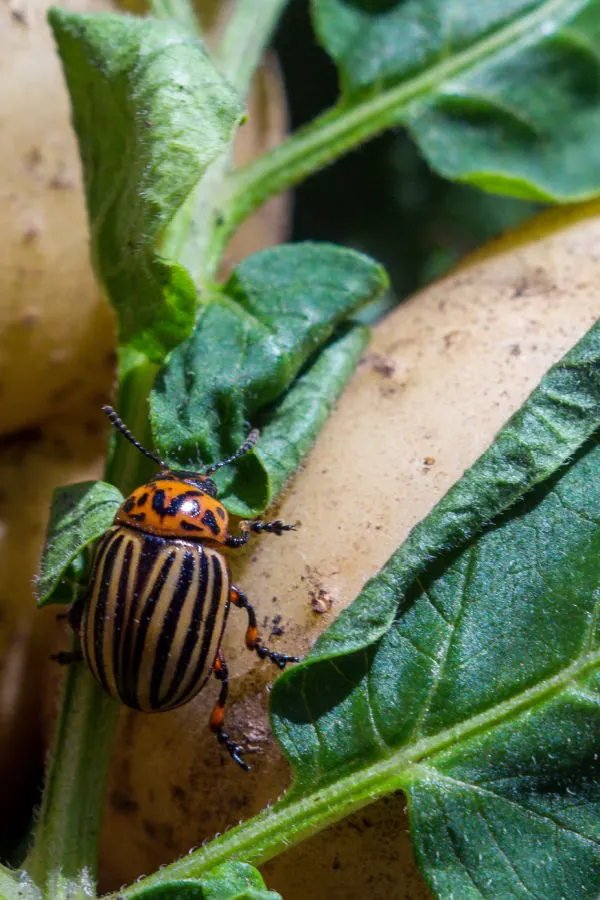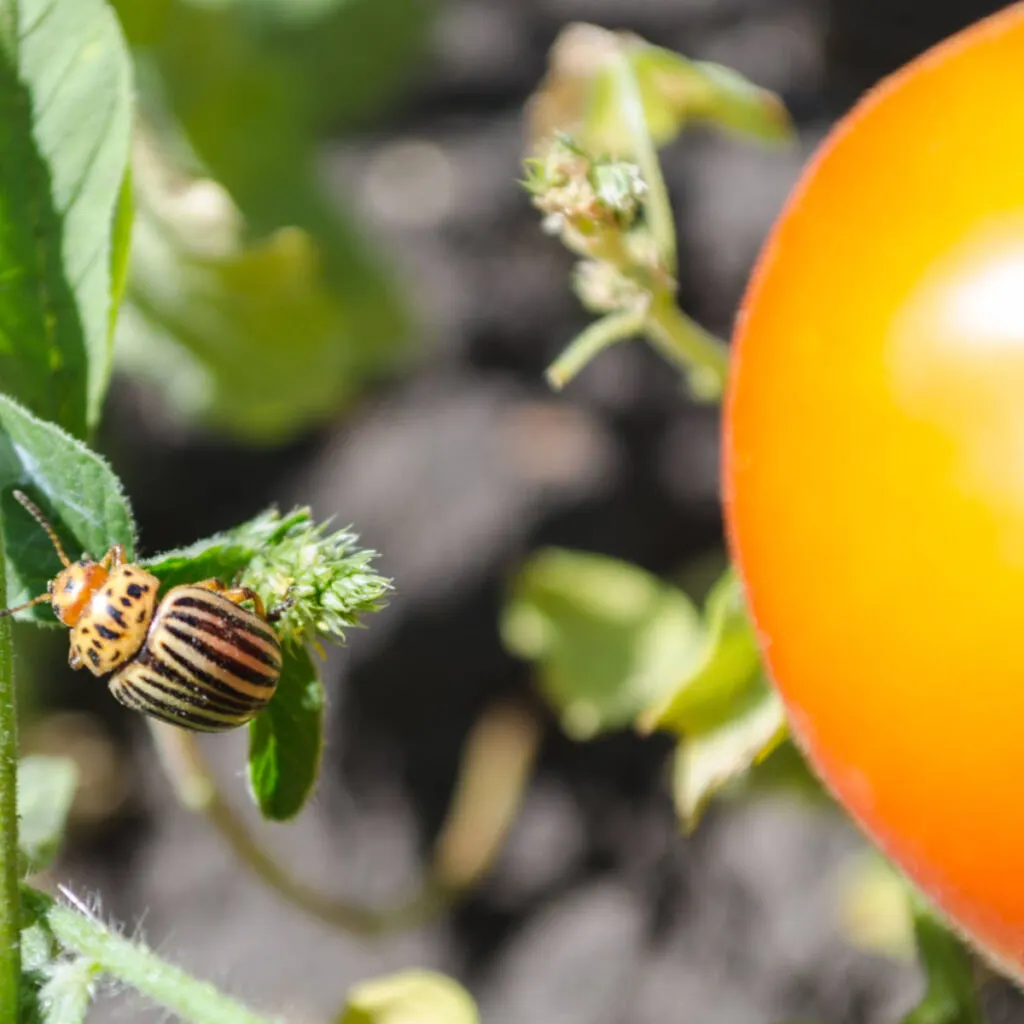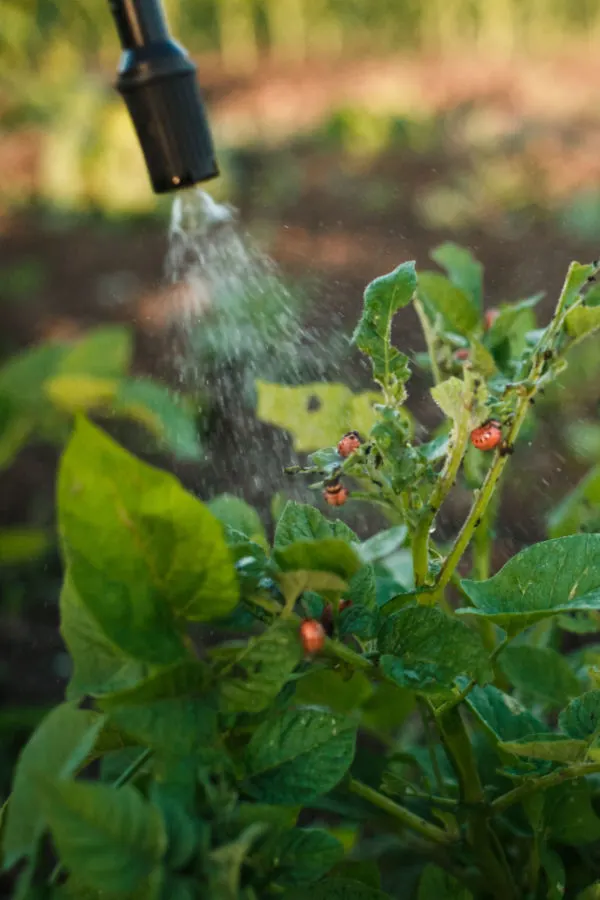Looking for a few effective methods to get rid of potato beetles and eliminate them without having to resort to harsh chemicals and insecticides?
Potato beetles can destroy the leaves of some of the most beloved vegetable plants in a home garden. Although they get their name from their love of attacking the foliage of potato plants, they will go after all of the nightshade family of plants, including tomatoes, peppers and even eggplant.
The damage they can cause can be swift and intense. Potato beetles defoliate plants and in the process stagnate a plant’s growth. Interestingly, it is the larvae of the potato beetles that start devouring the tips of the leaves first.

From there, the potato beetles then progress towards the entire leaf and the whole plant. Potato beetles will consume almost every part of the leaf, with the only exception being the veins of the leaves. And once leaves are heavily damaged, the plant has little ability to use photosynthesis to create energy for new growth.
Where Do Potato Beetles Come From – How To Get Rid Of Potato Beetles
Potato beetles (adults) hibernate in the ground at a depth of 4 to 12 inches over the winter. Once warmer weather arrives, they then begin to find their way out of the ground.
If potato beetles find a steady diet of vegetable plants, they will often take up permanent residence right in the garden each fall to come back the following spring. But they can also fly to find food. In fact, it is common for potato beetles to fly several miles to find suitable plants to consume.
That means that unfortunately, even if potato beetles do not stay in your garden, they can still make their way in to find your plants. As for timing, in most gardens, beetles begin to appear in late spring to early summer.
If allowed to establish and breed without issue, potato beetles can move from plant variety to plant variety. And as fast as they breed, they can quickly put an entire garden at risk.

The good news is there are a few simple and more importantly all-natural ways to combat the destructive pest. After all, who wants to spray dangerous insecticides on the very plants that grow the vegetables they will be consuming.
With that safe, organic and all-natural approach in mind, here is a look at some of the best ways to stop potato beetles in their tracks – and save the vegetable plants growing in your garden in the process!
How To Get Rid Of Potato Beetles Naturally – 6 Simple Methods That Work!
#1 Hand Picking – How To Get Rid Of Potato Beetles Naturally
This method requires the most effort, but many argue it is the most effective by far. By removing the adults and larva you put an end to the reproduction cycle in quick fashion. To hand pick, all you need are a pair of gloves and a bucket of soapy water to put the beetles and larva into.
When checking plants, adult potato beetles will be small and yellow. They will also have lines or stripes on their hard shelled backs. Younger potato beetles are reddish with hard shells and two rows of ridges on their backside. Simply pluck the beetles off an put them into the soapy water.
For the larvae, check the underside of the leaves for the collection of bright yellow eggs. Remove these from the leaves and put them in the soapy water as well. Removing the eggs is extremely important as they will be the next generation to attack your plants.

Adult potato beetles live for a year and can colonize a single plant for a month while building up their numbers and moving on to other plants. Continue monitoring your vegetable garden every few days to find and pick off any new beetles or larva that appears.
#2 Soap & Water Spray – How To Get Rid Of Potato Beetles Naturally
Another great way to eliminate potato beetles without having to resort to harsh chemicals is with a spray of soap and water.
To make, simply add two tablespoons of liquid soap (there are some great organic dish soaps that keep the mixture 100% all-natural!) to one gallon of water.
To use, put the mix into a hand help spray bottle or small sprayer and coat the leaves of your plants. When the spray comes into direct contact with the beetles or their larva, it kills them. Affiliate Product Link : Sonett Organic Dishwashing Liquid Soap
#3 Neem Oil – How To Get Rid Of Potato Beetles Naturally
Neem oil is another all-natural liquid that can be mixed with water to make an effective spray to kill potato beetles. Neem oil is made from the oil that is in the seeds of a neem tree. The oil has anti-fungal and antibacterial properties, and also is a natural insecticide to many insects, including the potato beetle.

The good news with neem oil is that it can be safe when sprayed correctly for important pollinators like bees and butterflies. Follow the directions on the bottle to mix with water and spray on the affected plants.
It’s important when buying neem oil to ensure that the oil it uses has the name Azadirachta Indica on it. Only that variant is effective against potato beetles. Product Affiliate Link : Cold-Pressed Azadiracthin Neem Oil Concentrate
#4 Companion Planting – How To Get Rid Of Potato Beetles Naturally
Companion planting can help eliminate beetles in your garden in three different ways. The first is that by growing plants the beetles can’t stand, it will drive them away in search of better areas to call home.
There are a few plants that highly discourage potato beetles from entering a vegetable garden. Chives, garlic, bush beans, catnip and nasturtiums are all plants that potato beetles are not fond of in the least. By planting these plants near your potato, tomato and other nightshade plants, it can help protect them from a beetle invasion.
The second way companion planting can help protect your plants is by attracting key predators of potato beetles. Lady bugs, lacewings and soldier beetles all love to attack potato beetles. And the more plants you can plant that bring these helpful insects in – the better!
Marigolds, zinnias, cosmos and thyme are all excellent plants to grow to bring in beneficial insects. By simply planting these near crops that can be attacked by potato beetles, you will bring their predators right to them!

Last but not least, you can also use companion planting to plant trap crops that attract beetles away from the plants you are trying to protect. Ground cherries are wonderful for this. Plant them far away from your garden’s most significant plants to attract them away. See: The Best Companion Plants For Tomatoes
Many people who don’t like eggplant will plant it simple to draw the beetles to it and away from their tomatoes, peppers and potatoes. Trap crops are great for luring the beetles you have to one place. Then you can hand pick them off with ease!
#5 Protecting Plants With Row Covers – How To Get Rid Of Potato Beetles Naturally
Row covers are one of the best natural methods to stop and eliminate potato beetles from ever getting to your plants in the first place. Row covers need to go on before the beetles emerge.
The only caveat is that during pollination, row covers need to be removed in order for pollinating insects to get to the blooms. The good news is that by the time flowers form on the nightshade family of plants, the beetles have already started to head back into the ground until the following season. Product Affiliate Link : Garden Plant Cover Row Cover
#6 Crop Rotation – How To Get Rid Of Potato Beetles
One of the best ways of all to eliminate potato beetles from ever finding a permanent home in your garden is with crop rotation. In fact, it should be every gardeners first line of defense. By changing the physical location of the crops that potato beetles love and planting them in a different section, it reduces the chance of the beetles overwintering in the soil.

Plain and simple, when you plant the same crops in the same space, they never have to leave! While this won’t reduce the damage by 100%, it can greatly keep populations under control. Here is to eliminating potato beetles this year, and to protecting your potatoes, tomatoes and other nightshade plants as well!
Follow Our Facebook Page For Great Gardening Tips And Advice! This Is My Garden Facebook Page
This Is My Garden is a garden website created by gardeners, for gardeners. Jim and Mary Competti have been writing gardening, DIY and recipe articles and books and speaking for over 15 years from their 46 acre Ohio farm. They publish three articles every week, 52 weeks a year. Sign up today to follow via email, or follow along!
